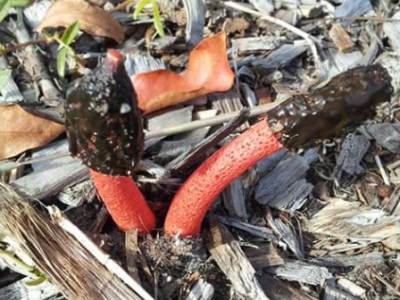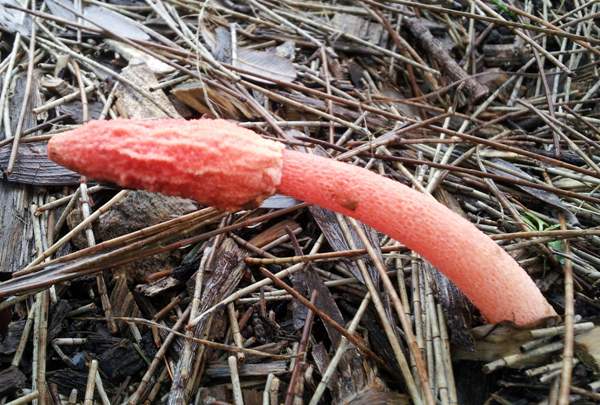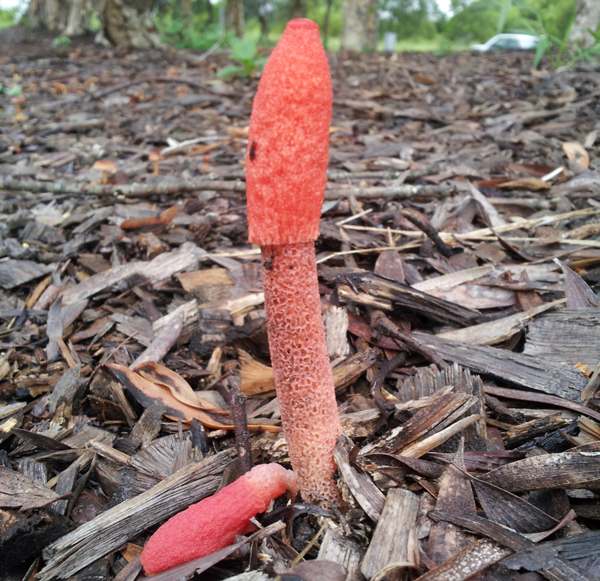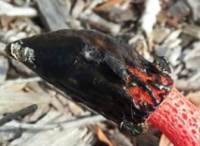Phallus rubicundus (Bosc) Fr.
Phylum: Basidiomycota - Class: Agaricomycetes - Order: Phallales - Family: Phallaceae
Distribution - Taxonomic History - Etymology - Toxicity - Identification - Reference Sources

Phallus rubicundus looks rather like a Mutinus stinkhorn species (for example see the Dog Stinkhorn Mutinus caninus); however, there is a significant difference: the gleba-bearing cap is separated from the stem (sitting on the top like a poorly-fitting thimble-shaped hat), whereas in Mutinus species the gleba is attached directly to the upper stem. This stinkhorn is sometimes confused with Mutinus elegans, a North America species with a spore-bearing surface integral with the stem.

Like other stinkhorns, Phallus rubicundus emerges from an 'egg' beneath the surface. The cap is initially covered with olive-green 'gleba', a smelly coating that attracts insects which in turn distribute the spores. (In the picture on the left, flies have eaten all of the gleba, and so the underlying pink cap is fully exposed.
Distribution
Not found in Britain and Ireland, Phallus rubicundus occurs in tropical parts of Asia, including India; in central and southern Africa, the Carribean and South America; it is also recorded in parts of North America as well as in Australia, where the pictures shown on this page were taken by Patrea Andersen. A similar common species found in Britain is Phallus impudicus, which has a white volva and a white stem, but in other macroscopic characteristics is very similar to Phallus rubicundus.

Taxonomic history
This stinkhorn species was originally described from South Carolina, USA, by French naturalist Louis Augustin Guillaume Bosc (1759 - 1828), who gave it the scientific name Satyrus rubicundus. That basionynm was subsequently sanctioned by Swedish mycologist Elias Magnus Fries who, in his Systema Mycologicum of 1823, renamed it Phallus rubicundulus.
Synonyms of Phallus rubicundulus include Phallus iosmus Berk., Hymenophallus hadriani (Vent.) Nees, and Phallus imperialis Schulzer.
Etymology
The genus name Phallus was chosen by Carl Linnaeus, and it is a reference to the phallic appearance of many of the fruitbodies within this fungal group.
The specific epithet rubicundus comes from Latin and means red or ruddy (rubicund!)..
Toxicity
The vile smell of many mature stinkhorn fungi might be taken to suggest that these fungi are toxic or at least inedible; however, some people do eat them at the 'egg' stage, when the odour is not so evident. When fully mature, stinkhorns are greatly valued as a source of food... by flies!
Identification guide
 |
DescriptionThe 'egg' from which this stinkhorn emerges is typically 3cm in diameter, gradually becoming elongated until it ruptures and the stem emerges quickly, bearing the gleba-coated cap aloft. Beneath the sticky olive-green gleba coating, the cap has a honeycomb structure. The stem is pink, hollow, and looks like expanded polystyrene, and it emerges from the remains of a pinkish universal veil that covered the fruitbody at the egg stage and ultimately remains around the base of the stem like a bag. These stinkhorns range from 6 to 15cm tall; stipe diameter is typically 1.5cm; the caps vary from 1.5 to 2cm across. |
SporesEllipsoidal, smooth, 3.6-4.2 x 1.6-2.0µm. Spore colourYellowish. |
|
Odour/taste |
A strong, unpleasant odour. |
Habitat & Ecological role |
Most often in leaf litter and on wood chip mulch. |
Season |
In tropical and sub-tropical climes stinkhorn fungi can fruit at any time of year when the humidity and temperature are high enough. |
Similar species |
Phallus impudicus, the Stinkhorn, has a white volva and stem. |
Reference Sources
Bosc L. (1811). 'Mémoire sur quelques espèces de Champignons des parties méridionales de l'Amérique septentrionale'. Magazin der Gesellschaft Naturforschenden Freunde Berlin 5: 86, t. 6:8.
Acknowledgements
This page includes pictures kindly contributed by Patrea Andersen.
Fascinated by Fungi. Back by popular demand, Pat O'Reilly's best-selling 450-page hardback book is available now. The latest second edition was republished with a sparkling new cover design in September 2022 by Coch-y-Bonddu Books. Full details and copies are available from the publisher's online bookshop...

